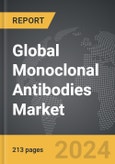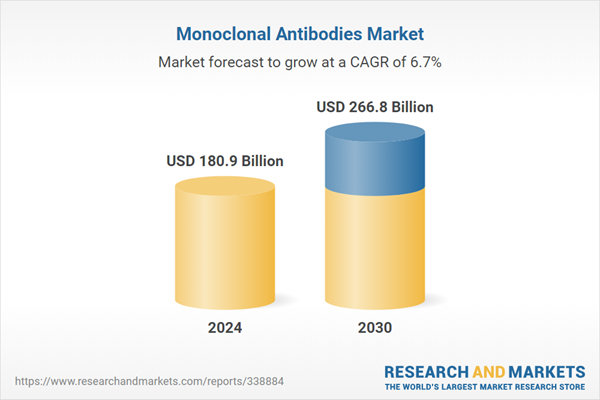The global market for Monoclonal Antibodies was valued at US$180.9 Billion in 2024 and is projected to reach US$266.8 Billion by 2030, growing at a CAGR of 6.7% from 2024 to 2030. This comprehensive report provides an in-depth analysis of market trends, drivers, and forecasts, helping you make informed business decisions.
The continuous evolution of biotechnological methods, including better cell line engineering and enhanced protein expression systems, has significantly improved the development and production of monoclonal antibodies. These advancements have increased the efficacy, safety, and stability of mAbs, making them more attractive for clinical use. There is a rising global prevalence of chronic diseases such as cancer, rheumatoid arthritis, and multiple sclerosis, where treatment with monoclonal antibodies has proven particularly effective. This increase in disease incidence has driven demand for targeted therapies that mAbs can provide. Overall, the monoclonal antibodies market is poised for continued growth and innovation, promising significant impacts on healthcare outcomes and offering substantial opportunities for pharmaceutical companies engaged in their development and commercialization.
The advent of next-generation antibody technologies has significantly enriched the therapeutic landscape. Innovations such as single-chain variable fragments (scFvs), nanobodies, bispecific antibodies, Fc-engineered antibodies, antibody biosimilars, antibody mimetics, and antibody-drug conjugates have all expanded the potential of mAbs in medicine. Today, antibody engineering has evolved to include a variety of formats beyond the traditional Y-shaped structure, such as single-domain antibodies (VHH), single-chain variable fragments (scFv), and antigen-binding fragments (Fab). These innovations expand the utility of antibodies in therapeutics by enhancing their specificity, reducing immunogenicity, and improving pharmacokinetics. The ability to modify antibodies through genetic engineering and mutagenesis has paved the way for the creation of fusion antibodies and other novel constructs designed to elicit enhanced immune responses, improve tissue penetration, and extend circulation half-lives. These capabilities have solidified monoclonal antibodies as a cornerstone of modern therapeutic strategies, particularly in treating complex diseases such as cancers and autoimmune disorders.
Monoclonal Antibodies - Key Trends and Drivers
Antibodies, crucial components of the immune system, are Y-shaped proteins produced by B lymphocytes in response to pathogen invasion. These molecules play a pivotal role in immunological defense, with each antibody tailored to recognize and bind to specific antigens, a characteristic that underpins their therapeutic potential in modern medicine. Monoclonal antibodies (mAbs) represent a significant sector in the biopharmaceutical industry, characterized by rapid growth and substantial contributions to medical treatments, particularly in the areas of oncology, autoimmune diseases, and infectious diseases. This growth is driven by several key factors and supported by emerging trends that are shaping the future of therapeutic monoclonal antibodies. The future of monoclonal antibodies looks promising with continued advancements in science and technology driving the market forward. As research deepens our understanding of diseases at the molecular level, mAbs are expected to play an increasingly vital role in medicine. Moreover, the integration of AI and machine learning in drug development pipelines is likely to enhance the specificity and functionality of monoclonal antibodies, potentially leading to more effective therapies with fewer side effects.The continuous evolution of biotechnological methods, including better cell line engineering and enhanced protein expression systems, has significantly improved the development and production of monoclonal antibodies. These advancements have increased the efficacy, safety, and stability of mAbs, making them more attractive for clinical use. There is a rising global prevalence of chronic diseases such as cancer, rheumatoid arthritis, and multiple sclerosis, where treatment with monoclonal antibodies has proven particularly effective. This increase in disease incidence has driven demand for targeted therapies that mAbs can provide. Overall, the monoclonal antibodies market is poised for continued growth and innovation, promising significant impacts on healthcare outcomes and offering substantial opportunities for pharmaceutical companies engaged in their development and commercialization.
The advent of next-generation antibody technologies has significantly enriched the therapeutic landscape. Innovations such as single-chain variable fragments (scFvs), nanobodies, bispecific antibodies, Fc-engineered antibodies, antibody biosimilars, antibody mimetics, and antibody-drug conjugates have all expanded the potential of mAbs in medicine. Today, antibody engineering has evolved to include a variety of formats beyond the traditional Y-shaped structure, such as single-domain antibodies (VHH), single-chain variable fragments (scFv), and antigen-binding fragments (Fab). These innovations expand the utility of antibodies in therapeutics by enhancing their specificity, reducing immunogenicity, and improving pharmacokinetics. The ability to modify antibodies through genetic engineering and mutagenesis has paved the way for the creation of fusion antibodies and other novel constructs designed to elicit enhanced immune responses, improve tissue penetration, and extend circulation half-lives. These capabilities have solidified monoclonal antibodies as a cornerstone of modern therapeutic strategies, particularly in treating complex diseases such as cancers and autoimmune disorders.
Report Scope
The report analyzes the Monoclonal Antibodies market, presented in terms of market value (USD). The analysis covers the key segments and geographic regions outlined below.Segments
Source (Human, Humanized, Chimeric, Murine); Indication (Cancer, Autoimmune diseases, Infectious diseases, Other Indications); End-Use (Hospitals, Research Institutes, Other End-Uses).Geographic Regions/Countries
World; United States; Canada; Japan; China; Europe (France; Germany; Italy; United Kingdom; Spain; Russia; and Rest of Europe); Asia-Pacific (Australia; India; South Korea; and Rest of Asia-Pacific); Latin America (Argentina; Brazil; Mexico; and Rest of Latin America); Middle East (Iran; Israel; Saudi Arabia; United Arab Emirates; and Rest of Middle East); and Africa.Key Insights:
- Market Growth: Understand the significant growth trajectory of the Human-sourced Monoclonal Antibodies segment, which is expected to reach US$105.2 Billion by 2030 with a CAGR of a 8.1%. The Humanized Monoclonal Antibodies segment is also set to grow at 6.9% CAGR over the analysis period.
- Regional Analysis: Gain insights into the U.S. market, valued at $47.9 Billion in 2024, and China, forecasted to grow at an impressive 11% CAGR to reach $62.1 Billion by 2030. Discover growth trends in other key regions, including Japan, Canada, Germany, and the Asia-Pacific.
Why You Should Buy This Report:
- Detailed Market Analysis: Access a thorough analysis of the Global Monoclonal Antibodies Market, covering all major geographic regions and market segments.
- Competitive Insights: Get an overview of the competitive landscape, including the market presence of major players across different geographies.
- Future Trends and Drivers: Understand the key trends and drivers shaping the future of the Global Monoclonal Antibodies Market.
- Actionable Insights: Benefit from actionable insights that can help you identify new revenue opportunities and make strategic business decisions.
Key Questions Answered:
- How is the Global Monoclonal Antibodies Market expected to evolve by 2030?
- What are the main drivers and restraints affecting the market?
- Which market segments will grow the most over the forecast period?
- How will market shares for different regions and segments change by 2030?
- Who are the leading players in the market, and what are their prospects?
Report Features:
- Comprehensive Market Data: Independent analysis of annual sales and market forecasts in US$ Million from 2024 to 2030.
- In-Depth Regional Analysis: Detailed insights into key markets, including the U.S., China, Japan, Canada, Europe, Asia-Pacific, Latin America, Middle East, and Africa.
- Company Profiles: Coverage of players such as Abbott Diagnostics, Inc. - Core Laboratory, AbbVie, Inc., Amgen, Inc., AstraZeneca PLC, Bristol-Myers Squibb Company and more.
- Complimentary Updates: Receive free report updates for one year to keep you informed of the latest market developments.
Some of the 123 companies featured in this Monoclonal Antibodies market report include:
- Abbott Diagnostics, Inc. - Core Laboratory
- AbbVie, Inc.
- Amgen, Inc.
- AstraZeneca PLC
- Bristol-Myers Squibb Company
- Eli Lilly and Company
- F. Hoffmann-La Roche AG
- Johnson & Johnson
- Merck & Co., Inc.
- Novartis International AG
Table of Contents
I. METHODOLOGYII. EXECUTIVE SUMMARY2. FOCUS ON SELECT PLAYERSIII. MARKET ANALYSISCANADAITALYSPAINRUSSIAREST OF EUROPESOUTH KOREAREST OF ASIA-PACIFICARGENTINABRAZILMEXICOREST OF LATIN AMERICAIRANISRAELSAUDI ARABIAUNITED ARAB EMIRATESREST OF MIDDLE EASTIV. COMPETITION
1. MARKET OVERVIEW
3. MARKET TRENDS & DRIVERS
4. GLOBAL MARKET PERSPECTIVE
UNITED STATES
JAPAN
CHINA
EUROPE
FRANCE
GERMANY
UNITED KINGDOM
ASIA-PACIFIC
AUSTRALIA
INDIA
LATIN AMERICA
MIDDLE EAST
AFRICA
Companies Mentioned (Partial List)
A selection of companies mentioned in this report includes, but is not limited to:
- Abbott Diagnostics, Inc. - Core Laboratory
- AbbVie, Inc.
- Amgen, Inc.
- AstraZeneca PLC
- Bristol-Myers Squibb Company
- Eli Lilly and Company
- F. Hoffmann-La Roche AG
- Johnson & Johnson
- Merck & Co., Inc.
- Novartis International AG
Table Information
| Report Attribute | Details |
|---|---|
| No. of Pages | 213 |
| Published | April 2025 |
| Forecast Period | 2024 - 2030 |
| Estimated Market Value ( USD | $ 180.9 Billion |
| Forecasted Market Value ( USD | $ 266.8 Billion |
| Compound Annual Growth Rate | 6.7% |
| Regions Covered | Global |









